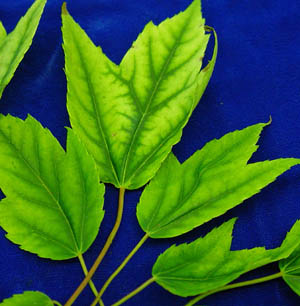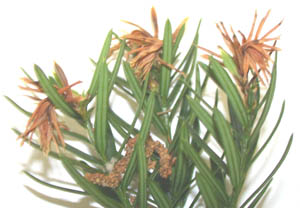Distinguishing Abiotic and Biotic Plant Problems | |
|---|---|
| April 25, 2007 | |
|
It is sometimes difficult to determine whether an environmental stress, insect, mite, chemical, or infectious plant pathogen is the cause of a plant problem. The infectious causes are classified as biotic (living) causes of plant problems. They include (but are not limited to) insects, mites, and disease pathogens. Environmental stresses, such as temperature injury and water or nutrient stress, are abiotic (nonliving) factors that may affect plant health. Often, multiple factors are to blame for plant decline, and we must determine which one(s) warrants our attention. The first steps in determining the cause of the problem is to identify the plant and become familiar with the symptoms. The plant may have areas of chlorosis (yellowing), necrosis (dead areas), or wilting. There may be total plant death, stem tip dieback, or burning of leaf edges or needle tips. One plant may be affected or many of the same species. In some way, the plant does not appear normal or healthy. Find out exactly how the plant is different from a healthy plant and carefully observe symptoms. To observe what is abnormal, you must have some knowledge of healthy plant appearance. Check species or cultivar information to determine normal plant appearance, particular sensitivities, and hardiness qualities. Look at similar plants in the community to observe their symptoms. Become familiar with diseases that may occur on your plant host and in your location. Even if you canít take the time to learn about all disease possibilities, there are many good reference books that you can use to scan the possibilities. As an example, if you have a mature elm that is wilting, a look in Diseases of Trees and Shrubs, by Sinclair and Lyon, can alert you to the possibility of Dutch elm disease. This book provides information on symptoms to look for and how to make a positive diagnosis. It is just as important to become familiar with noninfectious problems on the plant in your locale. It is fairly common knowledge that pin oaks and red maples in Illinois have problems with chlorosis, but did you know pines can be chlorotic in certain sites, too? This problem is widespread and often caused by the high-pH reaction of the soil, which inhibits absorption of iron and/or manganese. Root injury can contribute to symptoms. Noninfectious problems tend to appear frequently in a wide area and on the same host. The image shows chlorosis of red maple.  Because insect and mite problems frequently resemble diseases, knowledge of insect and mite problems on your plant is also helpful in accurate diagnosis. Yellowing and browning of inner needles on a spruce could be the result of a needle cast disease, nutrient stress, or possibly spider mites. Galls on trees might be the result of insect activity or disease infection. The pattern of injury in the landscape also provides some strong clues to the cause of the problem. If all trees in an area are affected, involving many species, I would be inclined to look for an environmental problem. This could be drought, flooding, compaction, or a similar problem. Frost damage, as seen on the yew stems in the image,  this season provides a good example of widespread noninfectious injury. Infectious diseases tend to be spotty and spread slowly among plants of similar species. When investigating a site, determine what species are affected and the pattern in the planting. this season provides a good example of widespread noninfectious injury. Infectious diseases tend to be spotty and spread slowly among plants of similar species. When investigating a site, determine what species are affected and the pattern in the planting. Accurate disease diagnosis requires some knowledge of how to identify disease pathogens. Common infectious agents of plant disease include fungi, bacteria, viruses, and nematodes. Of all the plant diseases that we might see in the landscape, only those caused by fungal pathogens have the ability to form fruiting bodies. These structures are the spore-producing bodies of the fungus; and they help considerably in proving the presence of a fungal pathogen. Fruiting bodies of Sphaeropsis (Diplodia) blight of pine confirm that a fungus is causing death of stem tips. Fruiting bodies of Rhizosphaera needle cast of spruce confirm that a fungal blight is causing interior needles to die. Mushrooms are fruiting bodies that indicate a wood or root rot when attached to a tree. Textbooks can help identify fruiting bodies, but often a laboratory is needed in pathogen identifications. The University of Illinois Plant Clinic can help. Information about the Plant Clinic appeared in the first issue of this newsletter. The final step in diagnosis is putting the facts together. Sometimes diagnosis is straightforward and easy, such as a case of crown gall on euonymus or powdery mildew on lilac. More often, however, there are multiple factors involved and they are less obvious. Always seek as much information as you can find and get the big picture. Put it together and talk to others about the problem. The process is challenging but also very rewarding. | |
| Author: | Nancy Pataky |
